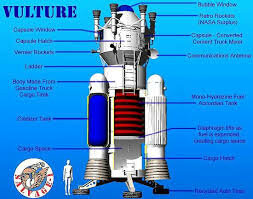Steve Pace
Aviation History Writer
- Joined
- 6 January 2013
- Messages
- 2,266
- Reaction score
- 222




 spacenews.com
spacenews.com

Post in thread 'The Space Junk Agency we need' https://www.secretprojects.co.uk/threads/the-space-junk-agency-we-need.34321/post-446094I can for see a comedy, science-fiction series about a merry band of orbital space junk salvagers.
Perhaps they were stranded in orbit after earth-based launch facilities fail, quit, sabotaged ...
Hah!
Hah!
Been done. Forty years ago. https://en.wikipedia.org/wiki/Salvage_1I can for see a comedy, science-fiction series about a merry band of orbital space junk salvagers.
Perhaps they were stranded in orbit after earth-based launch facilities fail, quit, sabotaged ...
Hah!
Hah!

Yes, they would. Derelict spacecraft still considered full property of the nation that launched it. The "Outer Space Treaty", "Convention on International Liability for Damage Caused by Space Objects" and "Convention on Registration of Objects Launched into Outer Space" firmly establish such position.Who is proprietary of, say, an old Soviet military satellite dead since 1973 ? Russia ? Could they protest the recovery of such an old wreck ?
Yes, they would. Derelict spacecraft still considered full property of the nation that launched it. The "Outer Space Treaty", "Convention on International Liability for Damage Caused by Space Objects" and "Convention on Registration of Objects Launched into Outer Space" firmly establish such position.Who is proprietary of, say, an old Soviet military satellite dead since 1973 ? Russia ? Could they protest the recovery of such an old wreck ?
The supposed salvage company would thus need to negotiate the transfer of ownership rights - or hire itself into service of derelict-owner nation, as part of space-cleaning effort.
I find this rule a little silly
Well if it was an American company it could at least start cleaning up dead American satellites.
A radar reflector inside BIG blobs of aerogel in a net: SplatNiks !!
FWIW, a space station has ideal conditions for manufacturing such: Free heat, free cold, high vacuum...
Plus, they'd make fair 'bumpers' for the ISS as the hazard count rises...
Here’s a report regarding where the last stage ended up.And someone just championed all previous performances. Shame on them (this kind of prehistoric launch profile should not be tolerated from a state run agency):

Huge rocket looks set for uncontrolled reentry following Chinese space station launch
The Long March 5B rocket which launched China’s first space station module Thursday is likely to undergo an uncontrolled reentry into the Earth’s atmosphere in the coming says.spacenews.com
We need regulations. Means we need an incentive to abandon ownership rights past a certain delay (= high taxes) or for recovering a launch sat by yourself or via a contractor (=low tax).
Also, ideally, it should be mandatory that all plans, hardware drawings and software usage should be made public* past a certain delay (decades?) to prevent potentially deadly accidents during recovery and harvesting processes and allow for direct re-use of sub-components.
… the burdens on spacecraft design that rocket launches impose, resulting in new and exciting possibilities in space.
If you design a satellite that was manufactured in orbit … we estimate that maybe 80% of the mass of a satellite being launched is there to support the launch loads, so that’s a significant component to how spacecraft are designed today… So if we can design satellites that are manufactured, assembled in orbit, can completely change the economics of those assets.

Existing thread below. Though I think it’s probably in the wrong section.… the burdens on spacecraft design that rocket launches impose, resulting in new and exciting possibilities in space.
If you design a satellite that was manufactured in orbit … we estimate that maybe 80% of the mass of a satellite being launched is there to support the launch loads, so that’s a significant component to how spacecraft are designed today… So if we can design satellites that are manufactured, assembled in orbit, can completely change the economics of those assets.

| EarthSky
Northrop Grumman said last week that its Mission Extension Vehicle 2 - a robot spacecraft designed to help prolong the life of satellites in space - successfully docked to a commercial communications satellite. "We are now the only provider of life extension services for satellites," a company...earthsky.org

I`ve heard that Space X is gonna make Starlink satellites will be able to lead themself in the atmosphere of Earth when their lifespan is over to burn down there and not to increase the number of space junk
